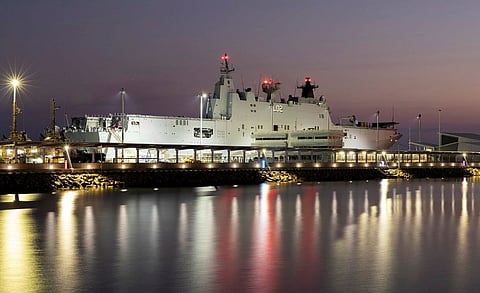

If you're confused about what's happening with the Port of Darwin after the recent federal budget and the media coverage that followed, you're not the only one.
It's always a challenge to penetrate the veil of Canberra's budget uncertainty and doublespeak, especially when it comes to both defence and northern Australia. It takes a lot to decipher whether a government infrastructure announcement in northern Australia is new money, a reannouncement of an existing commitment or a reallocation of resources to new investment.
On March 31, The Australian newspaper's Ben Packham wrote about a $1.5 billion allocation for "new port infrastructure, such as a wharf, an offloading facility and dredging of the shipping channel", that he'd found buried in the budget.
Defence Minister Peter Dutton fueled media speculation that afternoon when he hinted that support for this investment through defence projects could allow the Australian Defence Force and US military to bypass the Port of Darwin, which is under a 99-year lease to Chinese-owned company Landbridge Australia.
Finance Minister Simon Birmingham didn't help by suggesting early in the day that the investment was for a new port, before later confirming it was about new infrastructure.
So, is Darwin getting a second port? No.
The Northern Territory government, with industry and the Australian government, is trying to accelerate the development of Middle Arm in Darwin Harbour. The Middle Arm sustainable development precinct will centralise the territory's export and energy industries, focusing on low-emissions technologies, renewable hydrogen and carbon capture and storage.
The $2 billion in funding announced in the 2022–23 federal budget is a key enabler for the NT government's plan for the Middle Arm precinct. As Packham noted, the bulk of that money ($1.5 billion) will be spent on new port infrastructure to boost the region's importing and exporting ability. In addition, $200 million will go to further develop the precinct, delivering enabling infrastructure such as a rail spur and a new road network to strengthen supply chains. The remaining $300 million will support production in Darwin of low-emissions liquefied natural gas (LNG) and clean hydrogen and associated carbon capture and storage infrastructure.
The Middle Arm precinct's strategic location provides direct access to Darwin Harbour. It is to be connected to the territory's logistics network, including road and rail. The project has been recognised as nationally significant, is on the infrastructure priority list and could unlock more than $16 billion of private investment.
But it is most definitely not a second port.
So has the defence minister secured the investment necessary to ensure Darwin has sufficient infrastructure to support defence and national security contingencies? Not yet.
The development could provide Defence with access to new infrastructure. But it still doesn't address the ADF's or the US military's needs, especially for new amphibious capabilities and fuel security.
In 2020, Defence cancelled its proposed "roll-on, roll-off" wharf in Darwin. And we are yet to hear the details of what will happen next.
In September 2021, the US government awarded a tender to construct a $270 million fuel storage facility in Darwin to support US defence operations in the region. The new 300-megalitre facility will be owned and operated by Florida company Crowley Government Services. But an unresolved problem is that liquid fuels arriving in Darwin bound for this facility must pass through the Chinese-leased port.
The NT government's much-anticipated ship lift and marine industry park will provide the much needed scalable industry base to support future operations. However, it will still be adjacent to Darwin Port.
In no uncertain terms, US and Japanese officials have made it abundantly clear that the Port of Darwin lease arrangements would never have occurred in their jurisdictions. They've also made it clear to Australian officials that the lease impacts their current and future force posture decisions in northern Australia. Defence released its review of the leasing decision, which supports its previous advice that there are no problems with it. In the meantime, we wait for a decision from the National Security Committee of Cabinet on what ought to happen now.
Despite cancelling and delaying several projects, Prime Minister Scott Morrison and Dutton (and his predecessor Linda Reynolds) have repeatedly committed to spending $8 billion on defence capital infrastructure works over the next decade in the Northern Territory. While this kind of guaranteed investment is welcomed by the NT, it shows a commitment to spending but not a strategy.
The challenge isn't just about ending the lease of the Port of Darwin or spending more in northern Australia. It's about the development of a coherent and comprehensive strategy for the future of Darwin Port that's guided by Australian interests.
Today, everyone seems to have a plan for Darwin's port and harbour: the NT government, Defence, the US government, gas plant operator Inpex, port lessee Landbridge and the broader private sector. And as we saw last week, many of those plans have very real budgets. However, there's little evidence to suggest that the various ambitious visions are shared, let alone aligned.
So, has the government found a way to ensure that Australia, not a Chinese-owned private company, is guiding the future of Australia's most economically and strategically important northern port? In short, the answer is a resounding "no."
This needs to change.
